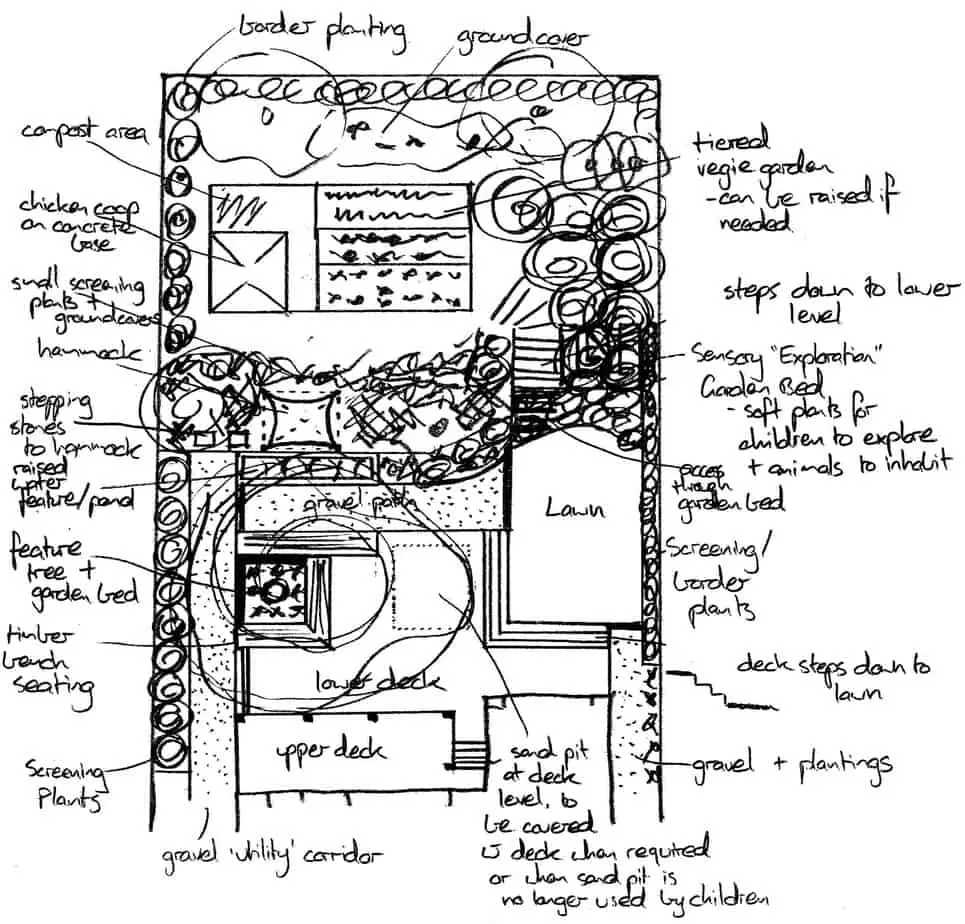Is this for me?
This is for anyone who:
DOESN’T KNOW where to start when trying to design their own garden.
Has MANY DIFFERENT IDEAS, but they are all separate and you don’t know how to put them all together.
Imagined a ROUGH PLAN. But you wants to explore a few more options and ideas.
Hates their EXISTING GARDEN and wants a quick make over. Or to combine existing elements with new garden decorating ideas.
OR wants to work from a CLEAN SLATE and learn some tips or tricks when it comes to starting a design.
This series will go in depth into each step. Understand the WHY and HOW behind each point. Develop a beautiful, functional garden that is unique to your backyard.
It starts with you collecting as many different home and garden design ideas as you can find. It doesn’t matter where they come from, or if you like the whole image you see, or even one small idea from it. Find videos, images on line or in print as well as real life examples through your everyday life.
Start to take note of things you like (or dislike) as you live your life. Don’t stick to only gardens.
Look at streetscapes, the city, public places, and other people’s houses.
Consider churches, galleries, alleyways, forests, beaches – everywhere you travel.
Look beyond your garden…
The key to sourcing ideas is to look beyond the style you like, or the size or situation you are dealing with. Don’t copy an idea and paste it into your garden. That is a mark of poor design – and we want great design!
Great design uses the local conditions to help shape an area or activity. Don’t draw random nice shapes on a plan. Great design recognises how and when you use certain spaces in the garden. Learn to place them in spots that take advantage of the local environment and climate. This enhances your design – taking it from poor to great.
Look beyond your specific condition. It is possible to draw ideas and inspiration from any number of different sources.
What will I find?
You can see that the internet is full of examples, tips, tricks and ideas for any number of garden types or areas. Things like:
Vegetable gardens – raised beds, companion planting, interior gardens, herbs…
Specific garden styles – Japanese gardens, French provincial gardens, English gardens, Cottage gardens, Mediterranean gardens, Modern gardens, Contemporary gardens, Native gardens, Formal gardens, Coastal gardens, Low maintenance gardens, Desert gardens, Tropical gardens, Drought tolerant gardens, Tuscan gardens, Country gardens, Xeriscape gardens, Colonial gardens, Southwest gardens, Spanish gardens, Winter gardens…
Small gardens – small balcony gardens, apartment gardens, interior gardens, courtyard gardens, raised garden beds, pot plants…
Specific activities – swimming pools, ponds, water features, bonsai, trampolines, backyard entertaining, outdoor dining, hammocks, cubby houses, playgrounds, basketball hoops, tennis courts, water slides….
How do they help me?
As you can see there is a ton of information out there. Plenty of decorating tips and tricks to try out if you’re on a budget.
The BIG PROBLEM is that they are all individual, separate ideas. They have no connection or relation to each other. This guide solves those problems. Look past the ‘thing’ and focus on how to make the ‘concept’ flexible and adaptable for your garden.
Follow a professional design process. You will end up with not one but MULTIPLE well thought out and designed plans. Use it in any number of ways. You can:
- Choose your favourite and refine it further. Clean it up. Draw it again. Make it suitable for tendering for construction.
- Use it as a guide if you want to construct or landscape yourself.
- Take it to an expert. A landscaper, builder, horticulturalist, or designer. Have them critique it. Offer suggestions. Or even quote it!
Regardless of how long it takes you to put in place, you know you have a plan that covers the whole backyard.
Even if you take years to fund or build each stage or area, everything will work together.
Because it all comes from the ONE PLAN.
And because it’s a drawing, you can always tweak and change things as you go. To account for more information or changes as they appear.

